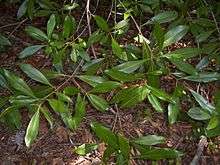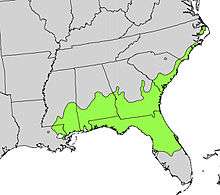Osmanthus americanus
| American olive | |
|---|---|
 | |
| Leaves of O. americanus | |
| Scientific classification | |
| Kingdom: | Plantae |
| Clade: | Angiosperms |
| Clade: | Eudicots |
| Clade: | Asterids |
| Order: | Lamiales |
| Family: | Oleaceae |
| Genus: | Osmanthus |
| Species: | O. americanus |
| Binomial name | |
| Osmanthus americanus | |
 | |
| US range | |
| Synonyms[1][2] | |
|
Synonymy
| |
Osmanthus americanus has been deprecated. A new genus has been created with two species, Cartrema americana and Cartrema floridana[3].
Osmanthus americanus, commonly called American olive,[4] wild olive,[4] or devilwood,[4] is an evergreen shrub or small tree[4] native to southeastern North America, in the United States from Virginia to Texas, and in Mexico from Nuevo León south to Oaxaca and Veracruz.[5][6]
Osmanthus americanus grows to 4–7 m (13–23 ft), rarely to 11 m (36 ft) tall. The leaves are 5–14 cm (2.0–5.5 in) long and 2–4 cm (0.79–1.57 in) broad, with an entire margin. Its flowers, produced in early spring, are small (1 cm long), white, with a four-lobed corolla and have a strong fragrance. The fruit is a globose dark blue drupe 6–15 mm (0.24–0.59 in) diameter, containing a single seed.[7][8][9]
It is cultivated as an ornamental plant in gardens for its fragrant flowers.
References
- ↑ "The Plant List".
- ↑ "The International Plant Names Index".
- ↑ "PhytoN-Cartrema_Oct30" (PDF).
- 1 2 3 4 Bailey, L.H.; Bailey, E.Z.; the staff of the Liberty Hyde Bailey Hortorium (1976). Hortus third: A concise dictionary of plants cultivated in the United States and Canada. New York: Macmillan. ISBN 978-0-02-505470-7.
- ↑ "Osmanthus americanus". Germplasm Resources Information Network (GRIN). Agricultural Research Service (ARS), United States Department of Agriculture (USDA). Retrieved 10 January 2018.
- ↑ Kew World Checklist of Selected Plant Families, Osmanthus americanus
- ↑ Weaver, R. E. (2003). Botany Section. Tri-ology 42 (6): 1-16 pdf file
- ↑ Centenary College Virtual Arboretum, Louisiana: Osmanthus americanus
- ↑ Huxley, A., ed. (1992). New RHS Dictionary of Gardening. Macmillan ISBN 0-333-47494-5.
| Wikimedia Commons has media related to Osmanthus americanus. |